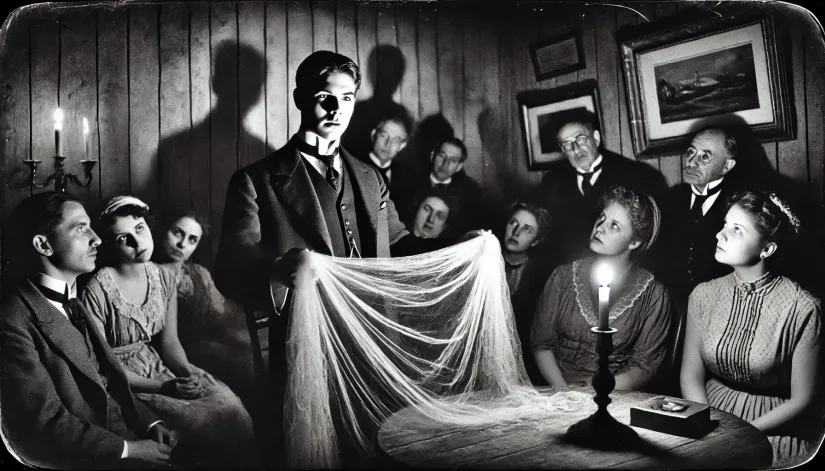Is ectoplasm proof of ghosts, or just an elaborate hoax? You know, this strange substance has fascinated people for over a century—ghost hunters, skeptics, believers, all of ’em.
What is ectoplasm? It’s that slimy residue at the scene of a supernatural event (or the gauzy stuff that mediums claim comes out during trances). It’s become the signature of ghostly phenomena… and a never-ending source of debate.
To really get what ectoplasm is all about, we have to dive into its roots—the spiritualist movement of the late 19th and early 20th centuries. I also want to explore how it’s supposedly manifested during hauntings and, of course, the hot debate about its authenticity.
So, what exactly is ectoplasm, and where did it come from?
In this article:

What is Ectoplasm?
Ectoplasm is this bizarre substance that allegedly emanates from mediums during séances or paranormal events. Simply put, it’s a mysterious substance that acts as a bridge, connecting our physical realm to the spirit world. It supposedly gives spirits a way to interact with us.
Etymologically, ectoplasm comes from the Greek words “ektos”‘ (meaning “outside”) and “plasma” (meaning “something formed or molded”).
Charles Richet (who proposed the term in 1894) wanted a term that would capture the notion of an external substance being shaped or molded by spiritual forces. Unlike its biological counterpart used in botany, the ectoplasm associated with paranormal activity refers to something distinctly otherworldly—a material bridge between the physical and spirit worlds.
You May Also Like: Do Residual Hauntings Fade Over Time? Why Some Ghosts Disappear
Richet also talked about something called the ectenic force. Some kind of psychic energy that mediums could tap into—allowing spirits to manifest in our world.
This concept suggested that mediums could harness a latent force within or around them, amplifying it to create physical manifestations (like ectoplasm). So, the ectenic force was this mysterious energy, almost like a psychic muscle, that needed careful focus and control.
Richet and other spiritualists argued that this force was the mechanism by which mediums could interact with spirits, creating a tangible link between the physical and ethereal realms.
What Does Ectoplasm Look Like?
Speaking of this mysterious substance, what does ectoplasm look like? Well, according to those who claimed to witness ectoplasm, it is gauzy, slimy, or mist-like.
Sometimes, it would be seen coming out of mediums’ mouths, noses, or even skin. It could be milky white, translucent, or sometimes even form weird, tendril-like shapes that seemed to reach out.
Related: Paranormal Cold Spots: What Are They and Why Do They Happen?
Now, here’s the thing. Why do these descriptions vary so much if it’s the same substance? Why is it sometimes sludgy and sometimes a smoke?
Ectoplasm in Spiritualism
The concept of ectoplasm was first “introduced” during the rise of the Spiritualist Movement. This was the late 1800s—a time when people were desperate to connect with loved ones they had lost and fascinated by the idea of an afterlife.
In July 1894, Charles Richet put a name to this strange phenomenon and called it ectoplasm. It wasn’t long before people were trying to see it for themselves.
Mediums like Eusapia Palladino and Helen Duncan became the faces of the movement. For example, Palladino was out there in Paris (as early as March 1898) performing séances where ectoplasm seemed to just show up out of nowhere.
These events were suspenseful, people on the edge of their seats. But not everyone bought into it. There were always skeptics in the crowd, questioning every move. I mean, who wouldn’t be a little suspicious when something bizarre happens right before you?

Helen Duncan and Her Incredible Séances
Helen Duncan started her séances in the early 1910s, and they were full-on performances. In fact, she was one of the few mediums at that time who claimed to produce ectoplasm regularly.
Of course, crowds showed up to see this milky, gauzy substance seemingly oozing out of her body during trances. Soon, Duncan became really famous, especially around the 1930s and early 1940s.
On November 25, 1941, she claimed to summon the spirit of a sailor during a séance in Portsmouth. This sailor allegedly provided details about the sinking of HMS Barham, a British battleship that had been torpedoed by a German U-boat.
Related: How to Connect with Someone Who Passed Away: Practical and Spiritual Methods
The shocking part? The sinking of HMS Barham wasn’t public knowledge at the time. In fact, the British government had kept the news under wraps to maintain morale during the war. Even more interesting was that the information Duncan produced was surprisingly accurate. She even mentioned the ship’s name and some of the sailors who had perished.
Naturally, this drew a lot of attention from authorities. The government became concerned that Duncan might be privy to classified military information—perhaps a leak from someone inside.
On January 19, 1944, Helen Duncan was arrested during one of her séances, accused of being a security risk. She was tried under the Witchcraft Act of 1735, which was almost unheard of by that time.
The trial was a spectacle, with Duncan’s supporters passionately defending her and skeptics ridiculing her claims. Despite the controversy, she was found guilty and sentenced to nine months in prison.
Her trial is often remembered as one of the last witch trials in Britain—a bizarre and dramatic echo of a bygone era.
After her release, Duncan largely stayed out of the public eye. However, her supporters continued to believe she had genuine powers. She died in 1956, still convinced of her abilities, and remains a polarizing figure in the world of spiritualism.

Albert von Schrenck-Notzing
Another key figure, Albert von Schrenck-Notzing, was a German physician and psychical researcher who dedicated much of his life to studying paranormal phenomena.
In April 1920, he published Phenomena of Materialisation, an exhaustive work that became a cornerstone for those who believed in ectoplasm. He focused on mediums like Eva Carrière (also known as Eva C.), one of the most prominent figures in the spiritualist community then.
Why was Schrenck-Notzing’s work so important? Because it compiled over 180 documented séances (many of them taking place between 1909 and 1913) to capture and analyze ectoplasmic materializations.
SpookySight Recommends:
- What Is Clairvoyance and How Does It Work?
- Inside the Warrens’ Occult Museum: Haunted Objects and Paranormal Controversy
- Hinton Ampner Haunting: Restless Ghosts, Poltergeist, or Ancient Curse?
His book included dozens of photographs of Eva C. supposedly producing ectoplasm, showing mist-like or gauzy substances emerging from her nose, mouth, and even ears. He also meticulously documented every séance, noting the exact conditions, temperature, lighting, participants, and the behavior of the medium throughout the process.
In his efforts to prove ectoplasm was real, Schrenck-Notzing employed what he described as strict protocols. For example, mediums were often tied to chairs, and their hands and feet were bound to prevent any trickery.
Despite these precautions, the scientific community was skeptical.

Is Ectoplasm Real?
Is ectoplasm real, or is it just another elaborate hoax? Honestly, most of the evidence points to it being a trick—something mediums have been faking for decades.
So many frauds have been exposed since the early 1900s. And it turns out a lot of the so-called ectoplasm was just cheesecloth, gauze, or even bits of animal tissue.
Take October 1912, when investigators uncovered several mediums using cheesecloth to create ectoplasm during séances. Even Helen Duncan (one of the most famous mediums) was caught in May 1933 for faking ectoplasm.
Did you know that the famous Harry Houdini made it his mission to expose fraudulent mediums and often went to séances specifically to uncover their tricks? That’s true. Houdini exposed dozens of mediums.
Not to mention that reputable scientists like Joe Nickell, Terence Hines, and Raymond Buckland all chipped in, pointing out the inconsistencies in the claims and providing solid evidence of deceit. They showed how simple materials and trickery could explain seemingly ghost manifestations.
I’ve got to be honest with you: I haven’t personally witnessed any ectoplasm manifestation despite attending numerous paranormal investigations and quite a few séances over the past decade. There’s always that hope to see it someday—but so far, nothing.
That said, I have to admit there have been some cases that are tough to explain away. For example, during séances with Eva Carrière (between 1909 and 1913), multiple witnesses claimed to have touched ectoplasm that didn’t look or feel like any ordinary material.
Franek Kluski’s séances, primarily during the early 1920s in Poland—often documented between 1920 and 1922—were another example. People described touching ectoplasm that seemed almost alive, unlike any fabric or substance they knew.
So, even if most of it was fake, there are still those lingering mysteries that keep me interested.
But overall, it’s hard to ignore the overwhelming amount of fraud that’s been revealed. While ectoplasm has become iconic in pop culture—thanks in part to movies like Ghostbusters and shows like Ghost Hunters—most of what we’ve seen historically has been debunked.
Still, that tiny part of me can’t help but wonder if there’s something more that we’ve missed…







